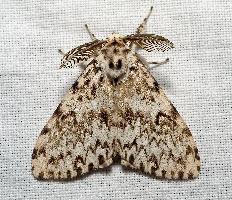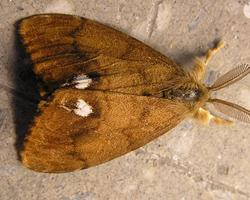
Poids et mesures
| Longueur | de 30 à 50 mm |
|---|
Description de l'animal
The Black Arches, scientifically named Lymantria monacha, is a captivating species of moth belonging to the family Erebidae. This moth is widely recognized for its distinctive appearance and the impact it has on forest ecosystems, particularly in the regions it inhabits. Originating from Eurasia, the Black Arches has expanded its range to include various parts of Europe and Asia, demonstrating its adaptability to different environmental conditions.Adult Black Arches moths exhibit a striking coloration that serves as their most identifiable feature. The wings are primarily white or light grey, adorned with a series of black bands and spots that create a unique pattern, reminiscent of the intricate designs found in nature's artistry. The forewings are particularly notable for their broad, dark margins and a central band that gives the moth its common name. The hindwings are somewhat plainer but still carry the characteristic dark markings. This distinctive coloration not only makes the Black Arches a subject of fascination among entomologists and nature enthusiasts but also serves as a camouflage mechanism in their woodland habitats, protecting them from predators.
The wingspan of the Black Arches ranges between 40 to 50 millimeters, positioning it as a medium-sized moth within the Lymantriidae family. Its body is robust, with a furry thorax that provides insulation, a crucial adaptation for surviving in the cooler climates of its native and introduced ranges.
The lifecycle of Lymantria monacha is an intriguing process, encompassing the moth's metamorphosis from egg to adult. Eggs are laid in batches on the bark of trees and hatch into caterpillars that are voracious feeders. The caterpillar stage is critical, as it is during this time that the Black Arches can have a significant impact on forest health. The larvae prefer coniferous trees, such as pines and spruces, but are not averse to feeding on a variety of deciduous trees. Their feeding habits can lead to defoliation and, in severe infestations, the death of trees, highlighting the moth's role as a pest in forest ecosystems.
The pupal stage follows the larval phase, with the caterpillar forming a cocoon in which it will undergo metamorphosis. The transformation from pupa to adult is a fascinating phase of the Black Arches' life cycle, culminating in the emergence of the moth, ready to begin the cycle anew.
The Black Arches moth plays a dual role in its ecosystem. On one hand, it is a vital component of the food web, serving as prey for a variety of birds, bats, and other predators. On the other hand, its larval feeding habits can pose significant challenges to forestry management, necessitating careful monitoring and control measures in areas where the species is abundant.
In conclusion, the Black Arches (Lymantria monacha) is a species of moth that intrigues and challenges humans in equal measure. Its beautiful appearance belies the potential threat it poses to forested areas, making it a subject of ongoing study and management efforts. As with many species, understanding the Black Arches' role in its ecosystem is key to appreciating its place in the natural world and the delicate balance that must be maintained to ensure the health of our planet's forests.
Animaux similaires
Nouvelles photos d'animaux
Top 10 des animaux
- Dolphin gull (Leucophaeus scoresbii)
- Japanese macaque (Macaca fuscata)
- Stone loach (Barbatula barbatula)
- Greek tortoise (Testudo graeca)
- Russian tortoise (Testudo horsfieldii)
- Galápagos tortoise (Geochelone nigra complex)
- Diana monkey (Cercopithecus diana)
- Moustached guenon (Cercopithecus cephus)
- Common flying dragon (Draco volans)
- Galápagos penguin (Spheniscus mendiculus)
